Here I explain music theory, simplified for electronic music producers. I focus on modern western pop music, so I skip most of the complex topics and give you basic knowledge to compose music.
While this is a quick start, with many shortcuts, I encourage you to continue leaning more music theory and especially reading and writing scores. It will have better conversations with other musicians and it gives you a deeper understanding of the described concepts.
Table of Contents
- Tones
- Frequency
- Loudness
- Waveform
- Modern Western Music
- Names for Notes
- Octaves
- Semitones
- Musical Scale
- Major Scales
- Minor Scales
- More About Scales
- Time and the Beat
- Note Values
- Will be Continued...
- GNU Free Documentation License
Tones
Music is all about tones.
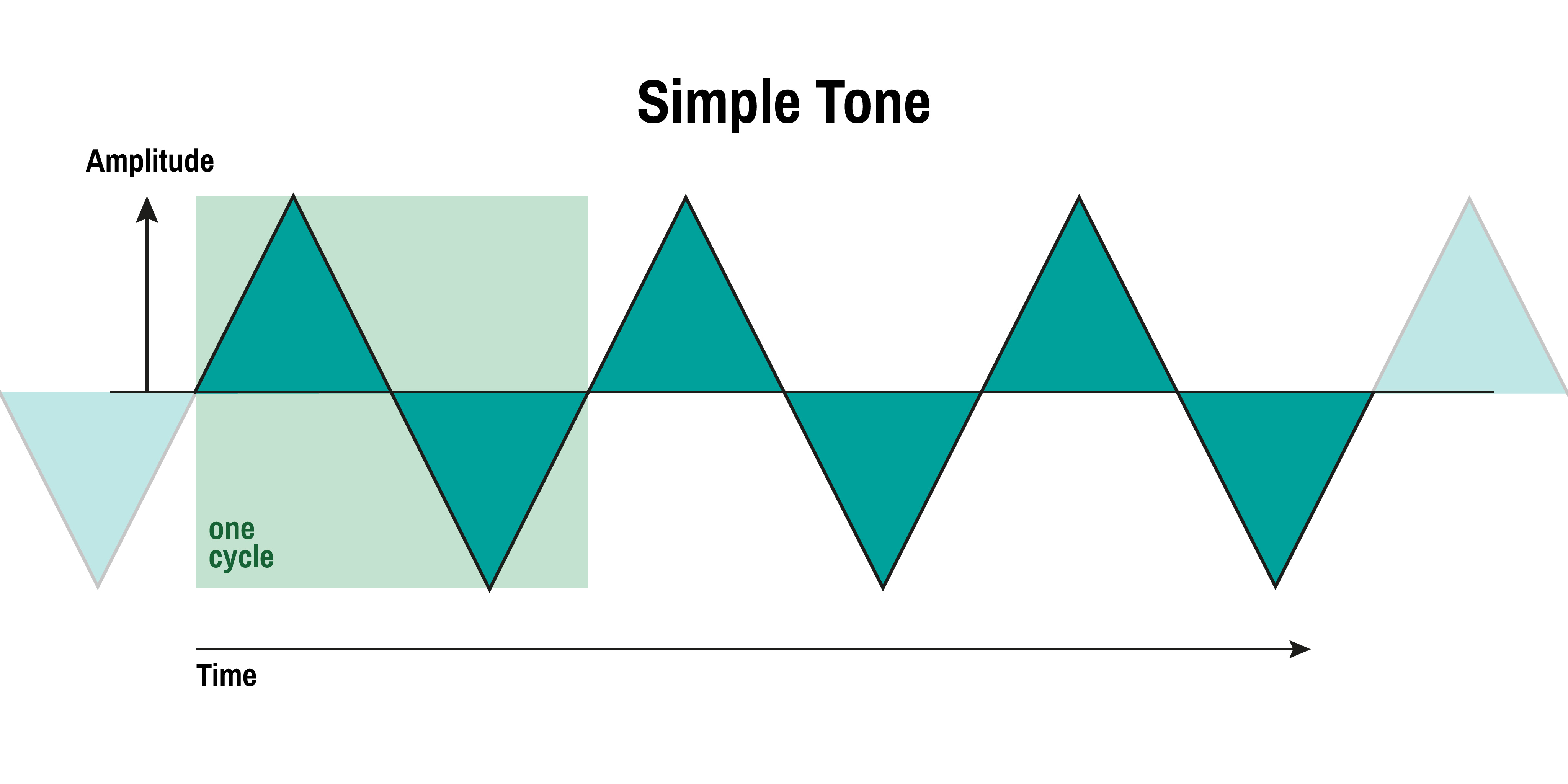
As soon, as something moves in the air in regular intervals and the waves in the air hit your ear - you perceive it as a tone. If these waves cycle faster, with shorter intervals, you hear a higher tone. On the opposite, you perceive slower waves cycles as a lower tone.
A large amount of your brain is dedicated analysing all the waves in the air around you and trying to interpret them as tones. That is the reason, why you can even think to hear tones in random noise.
Therefore, a tone is repeating air movement over time.
Frequency
The frequency defines how high or low you perceive a tone.

How high or low you perceive a tone depends on how fast the cycles repeat. This speed is called frequency and is measured in the number of cycles per second. This unit is called Hertz (named after the German physicist Heinrich Hertz), but usually, you only see the abbreviation Hz.
If you read, the frequency is e.g. 440 Hz, it means there are 440 cycles per second. Higher numbers, and therefore higher frequencies are higher tones. Lower frequencies with lower numbers are lower tones.
Humans usually perceive frequencies between 20 Hz and 20 kHz (20'000 Hz). Be aware, “usually” means that while most humans have hearing in this range there are people that can perceive lower and higher frequencies.
Loudness
A large amplitude results in a loud tone, a small in a quiet one.
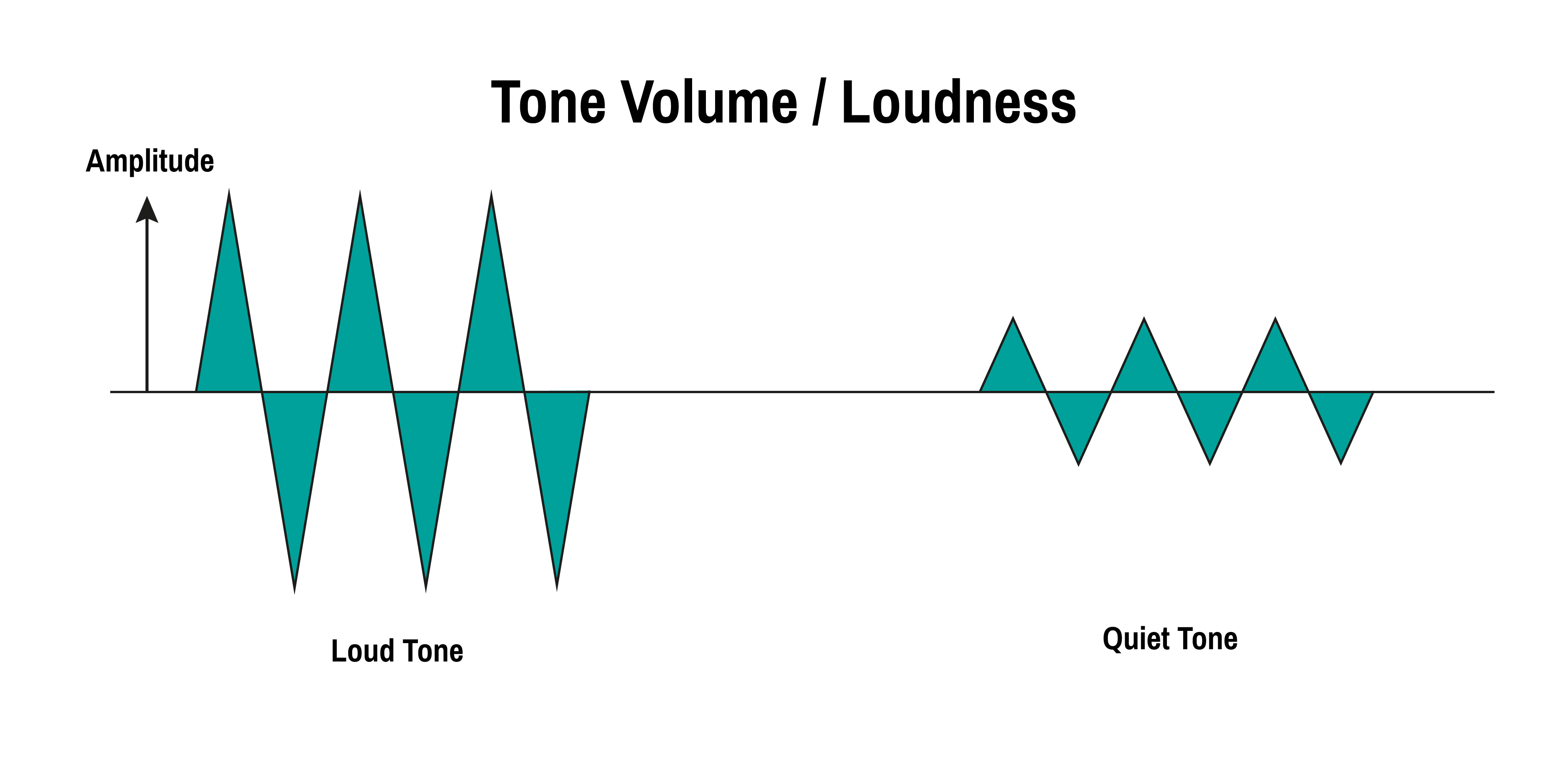
This is simplified: The loudness of a tone depends on the size of the amplitude. If the distance between the upper and lower peeks of a cycle are large, a tone is louder. If they are small, the tone is quiet.
The perceived loudness of a tone also depends on the shape of the waveform and the frequency.
Waveform
A waveform is the shape of a cycle in a tone.
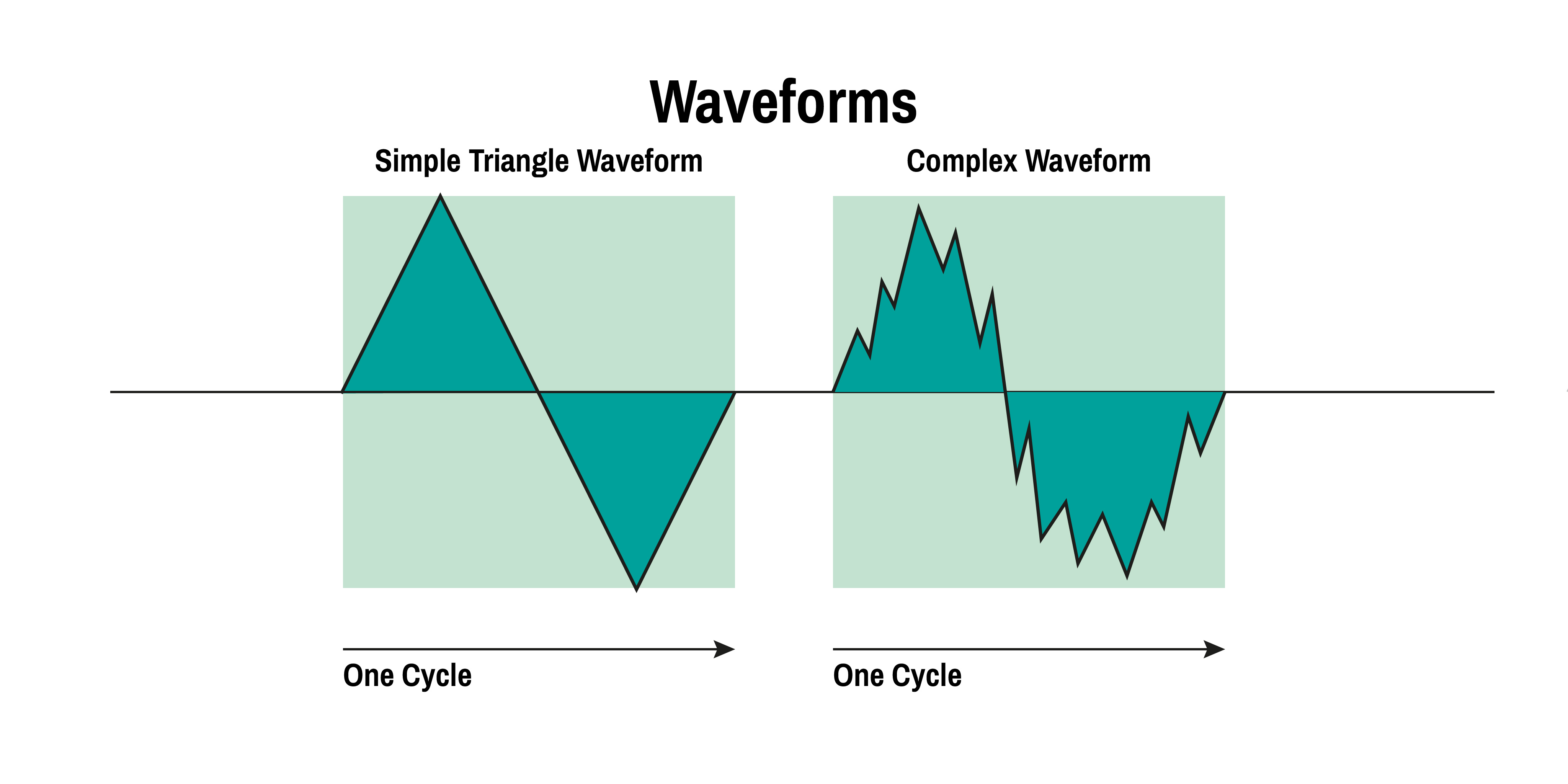
In electronic music, a common term is waveform. The waveform describes either the shape of a single cycle or a full sequence of cycles, also called sample.
The shape of a waveform defines the sound of a tone.
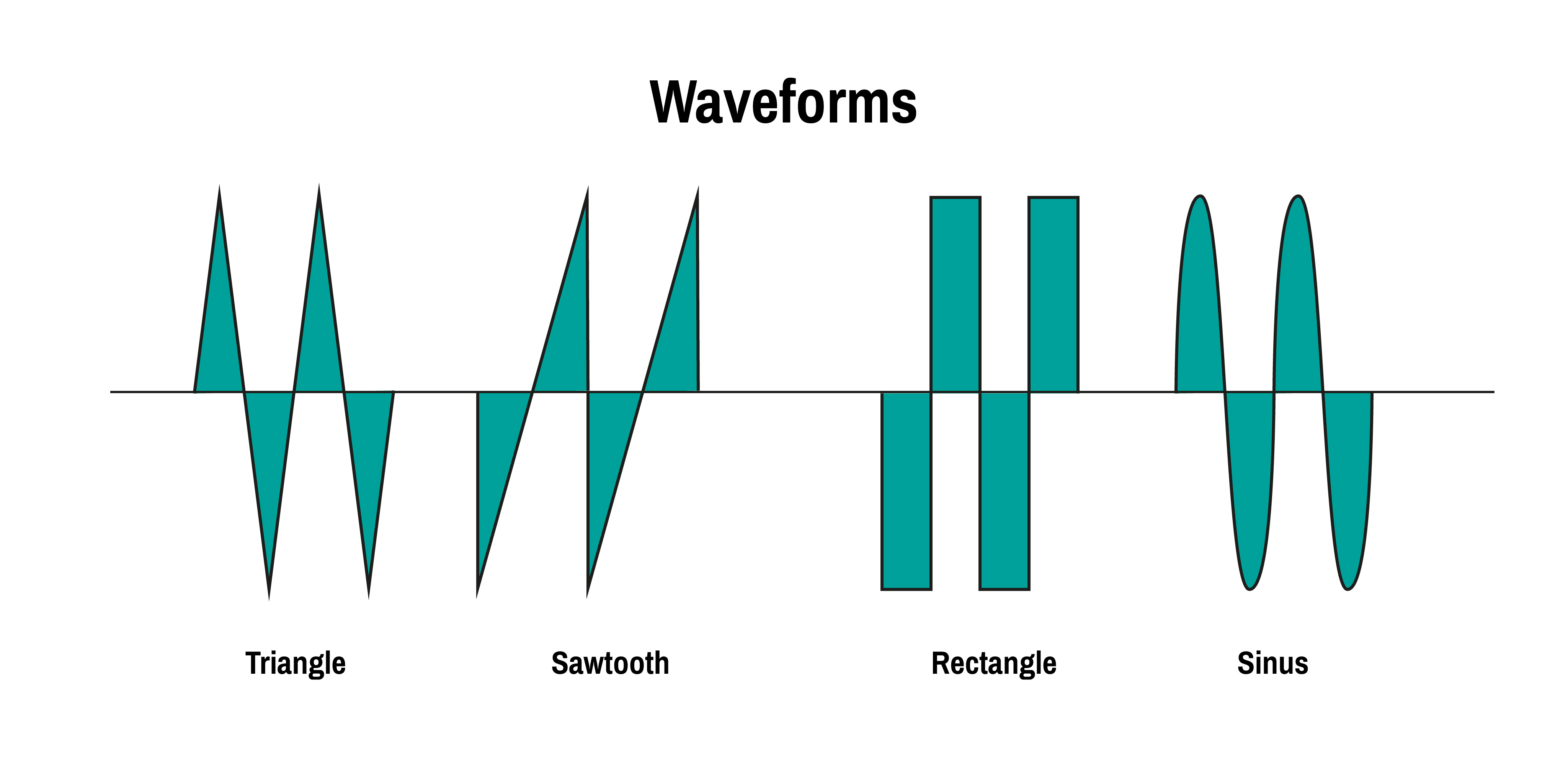
The four waveforms above are very common for building synthesisers, but usually waveforms for more natural sounds are way more complex. They are in fact typically that complex you cannot visually spot them. The following image is showing a short section of the waveform of a natural string sound.
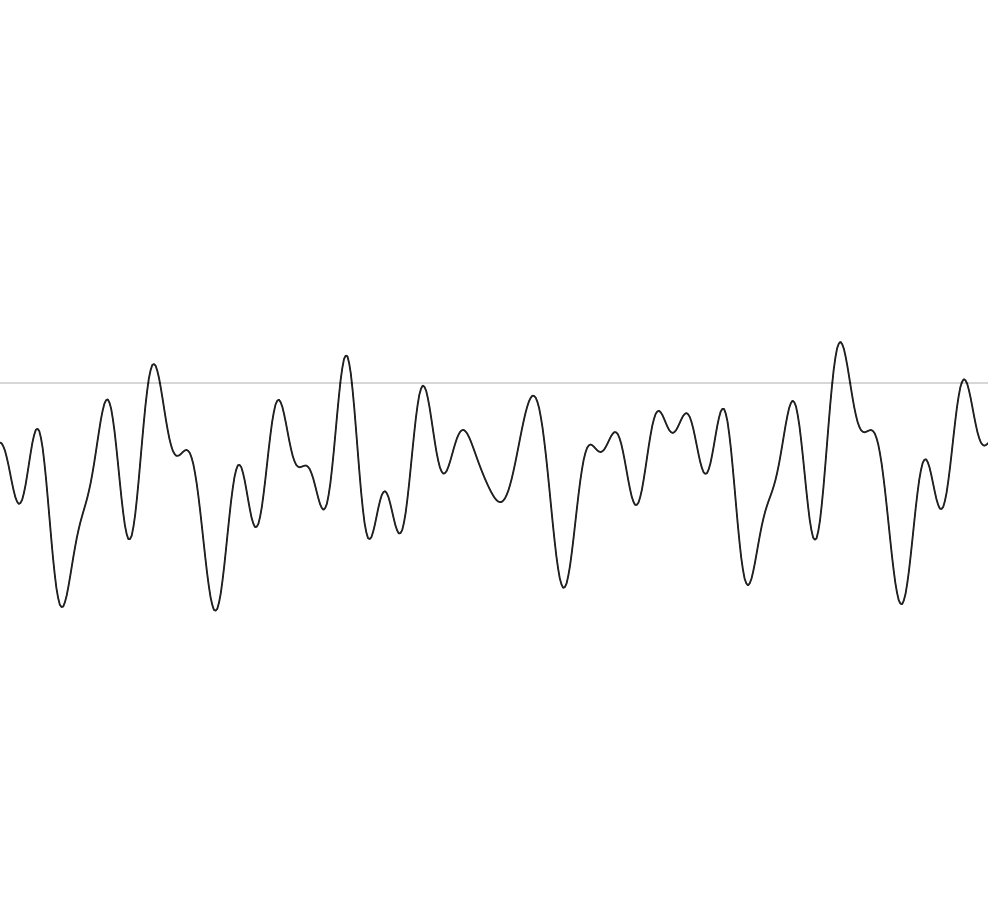
We talk about the perceived pitch of complex waveforms like this. The perceived pitch is often, but not always the lowest frequency in a sound, also called fundamental frequency. Two different waveforms played at the same frequency can be perceived as two different pitches.
Modern Western Music
After lots of experimentation and confusion, western countries ended up with the chromatic scale with a 12 equal temperament tuning. If you produce modern pop music, this is the only scale and temperament you will ever use.
Scale
A scale is a set of defined pitches. The chromatic scale defines 12 pitches, we will call notes from now on. All modern western music is based on these 12 notes. This definition of the chromatic scale is also the reason why a piano keyboard is grouped in multiple sets of 12 keys.
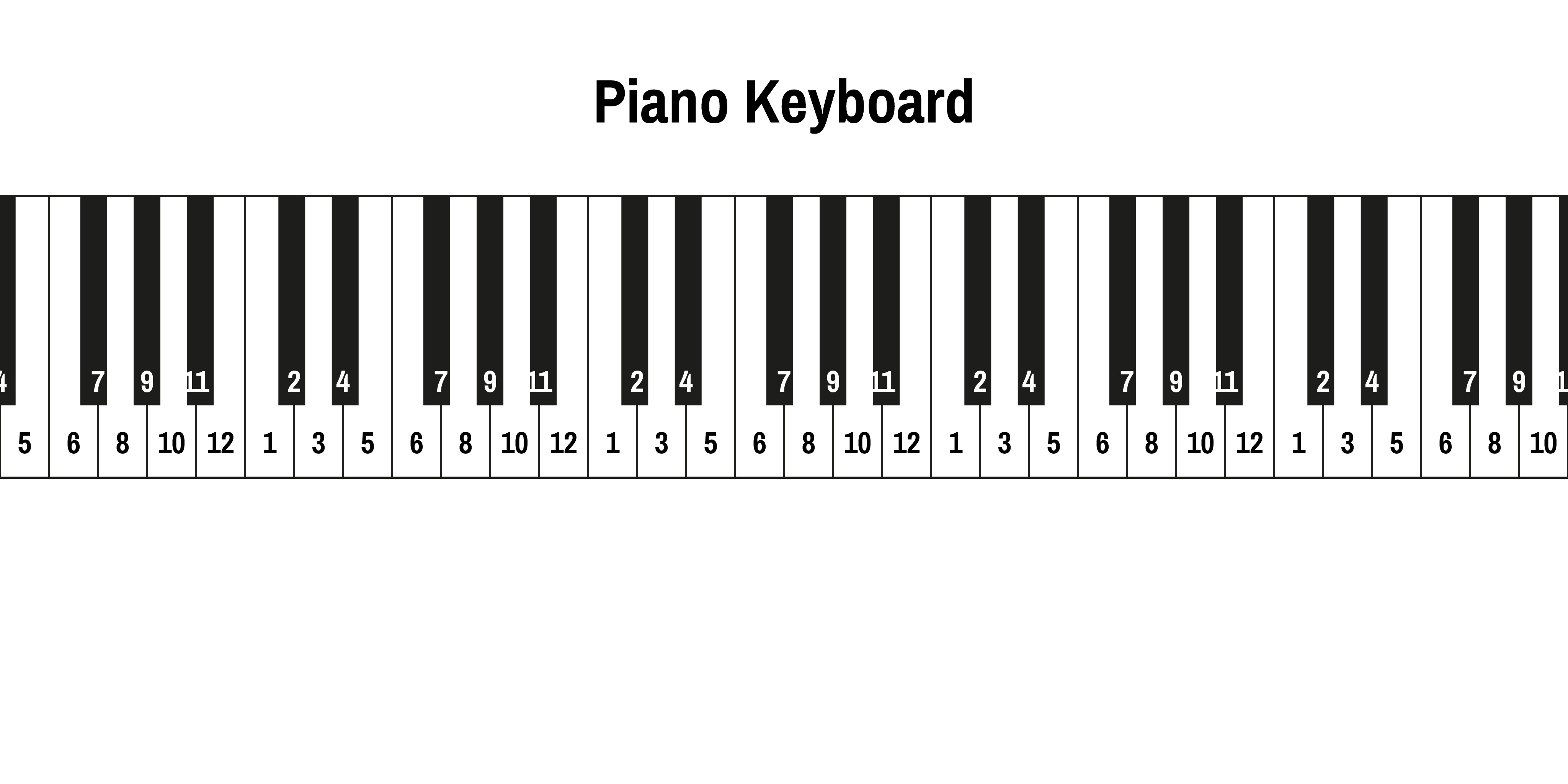
You see in the illustration above that the same 12 notes repeat over the whole keyboard. The reason for this repetition is how humans perceive frequencies. More about this later.
Musical Notes
From now on, we will use the term note for a sound in one of these 12 defined pitches. In the English language, the term note stands for the pitch of a sound, but also for the symbol in musical notation ♩. As we will not discuss the musical notation in this document, we use the term note for a sound at a defined pitch.
Names for Notes
The world more or less agreed on the same names to simplify talking about these 12 notes in the chromatic scale.
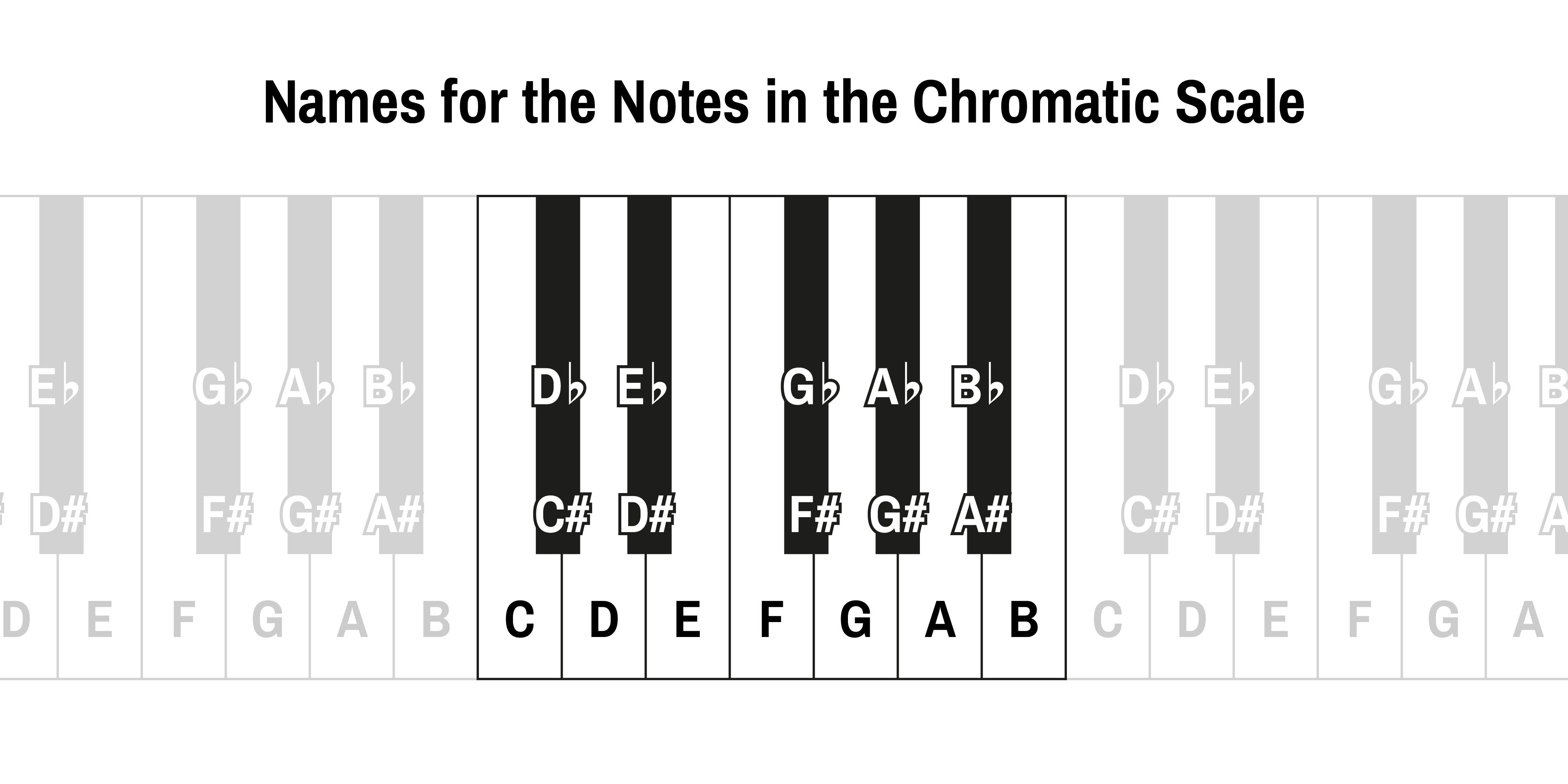
The White Keys
The naming is based on the white keys on a piano. These keys are named A, B, C, D, E, F and G. See the names of the keys above.
The block is not starting at the note A as you might expect, but instead with C. This is owed the reference tone, which is located at the note A. More about this later.
About the note name “H”
In many countries, the note B is called H for historical reasons. If you read the note name H somewhere, just replace it with B. These are just two different names for the same note.
The Black Keys / Sharp and Flat Signs
The black keys have no unique names. Instead, their names are derived from the location of nearby white keys. This is often a source of confusion.
As each black key has two neighbouring white keys, it also has two names.
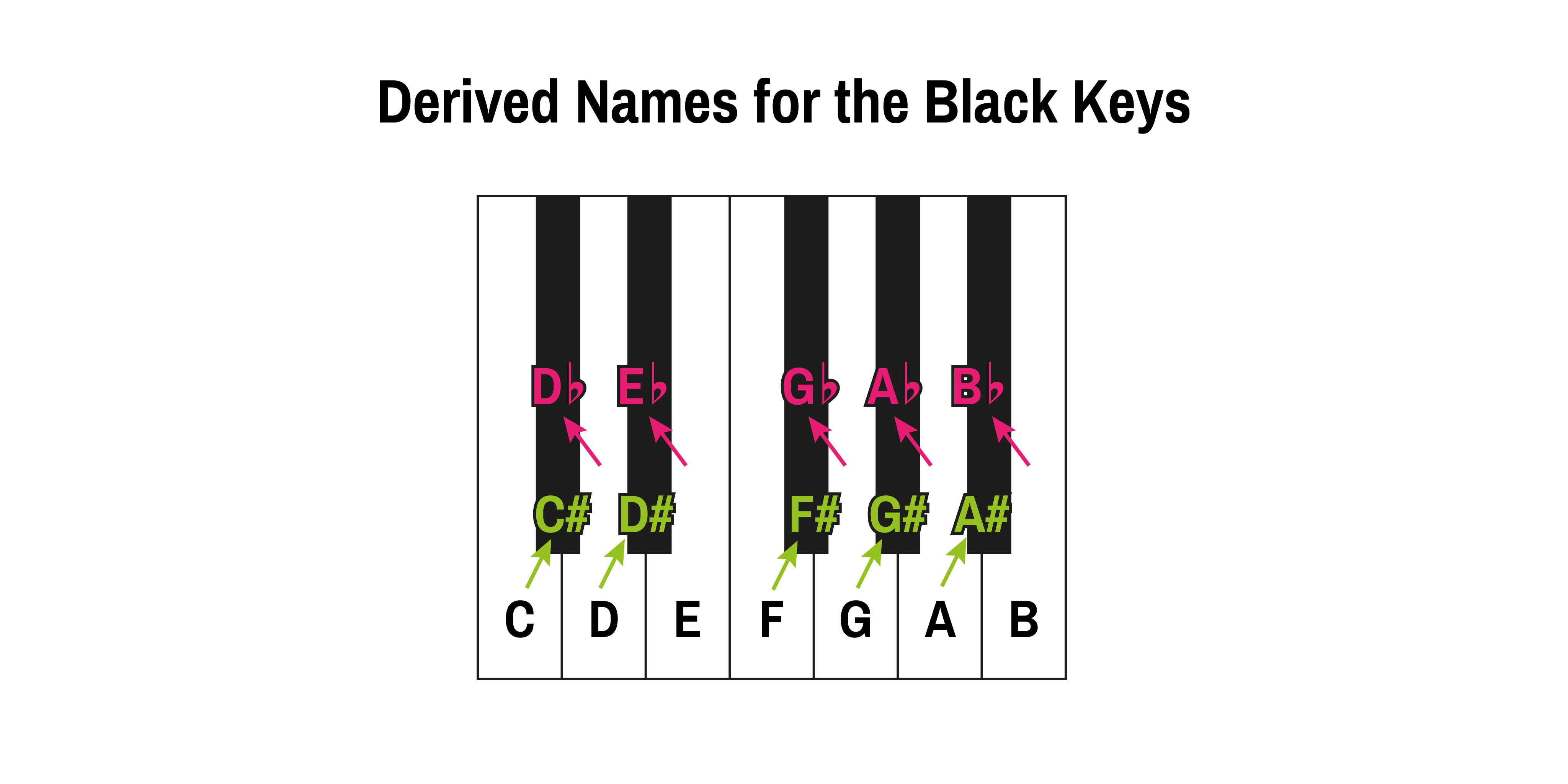
If you go to the black key on the right of a white key, you add the sharp-sign # to the note name. If you write all 12 note names in sequence you get:
But there is also the second notation using flat-signs ♭. If you go to the black key on the left of a white key, you add the flat-sign ♭ to the note name. If you write all 12 note names in sequence you get:
If you like to learn read and write musical scores, you need to know this notation and its usages in detail. For the start, all you need to know how to locate the right key if you read a note name.
Flats on F and C / Sharps on E and B
Sometimes you will read flat-signs ♭ on the note F and C. In this case, this means that you move from F to E, or from C to B. The same is true for sharp-signs # on the note E and B. Here you move one key up from E to F or from B to C.
Octaves
The distance between each block with 12 notes is called an octave. The term octave stands for that interval of notes where the frequency of the tone doubles.
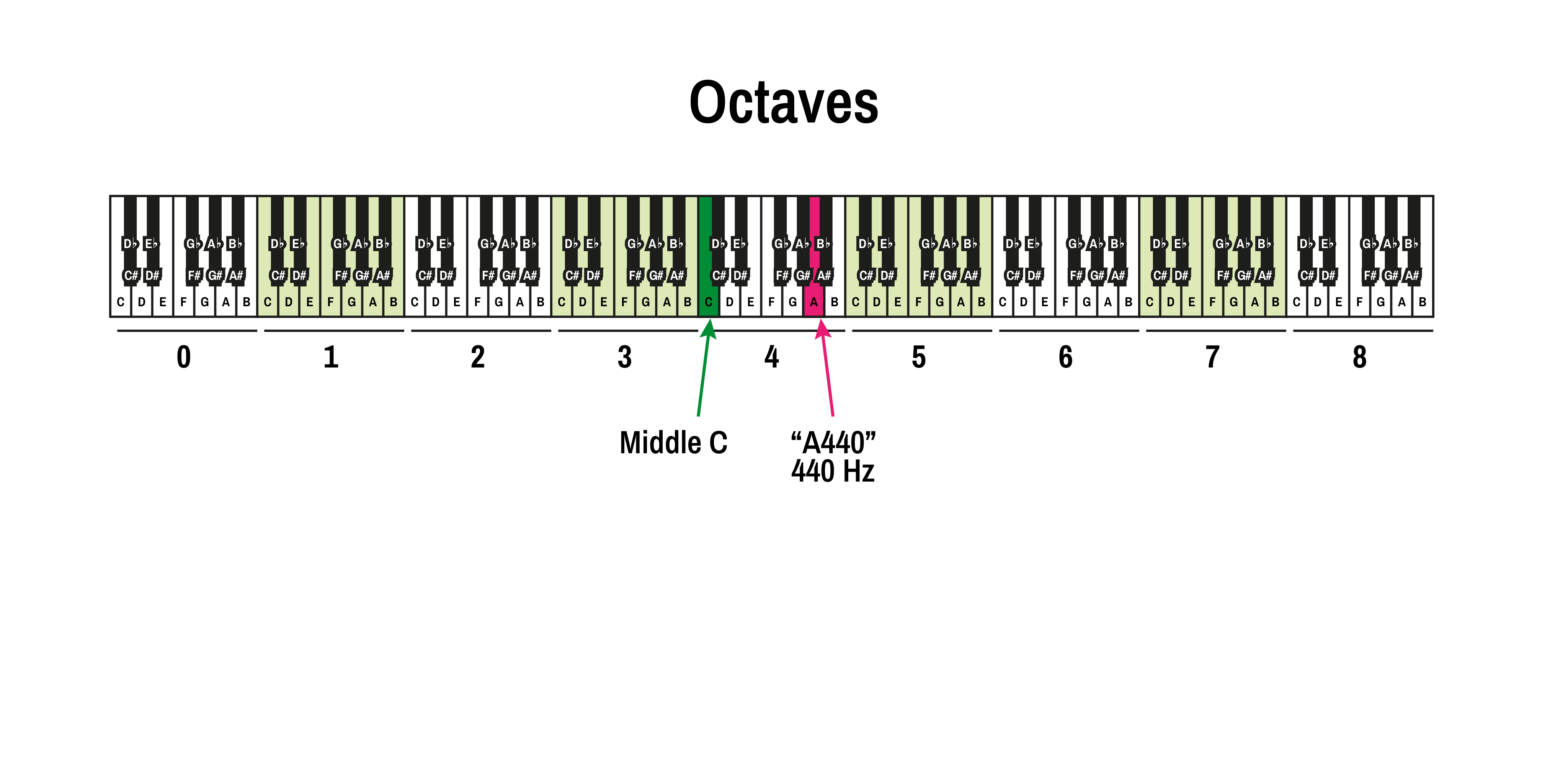
In digital music, a number is added after the name of each note to describe the octave. “A4” stands for the note A in octave 4. A standard 88-key piano has seven octaves plus three lower notes (B0, B#0 and A0) below the bottom C1.
There are two special notes: C4 is also called middle C. It is in the centre of a piano keyboard and often used as the reference note for playing samples.
The note A4 is also called A440. It is the reference for the tuning instruments. This note is tuned to the frequency of 440Hz and the frequency of all other notes are derived from this reference point.
Octaves Double the Frequency of a Note
The frequency of a note one octave higher doubles its frequency.
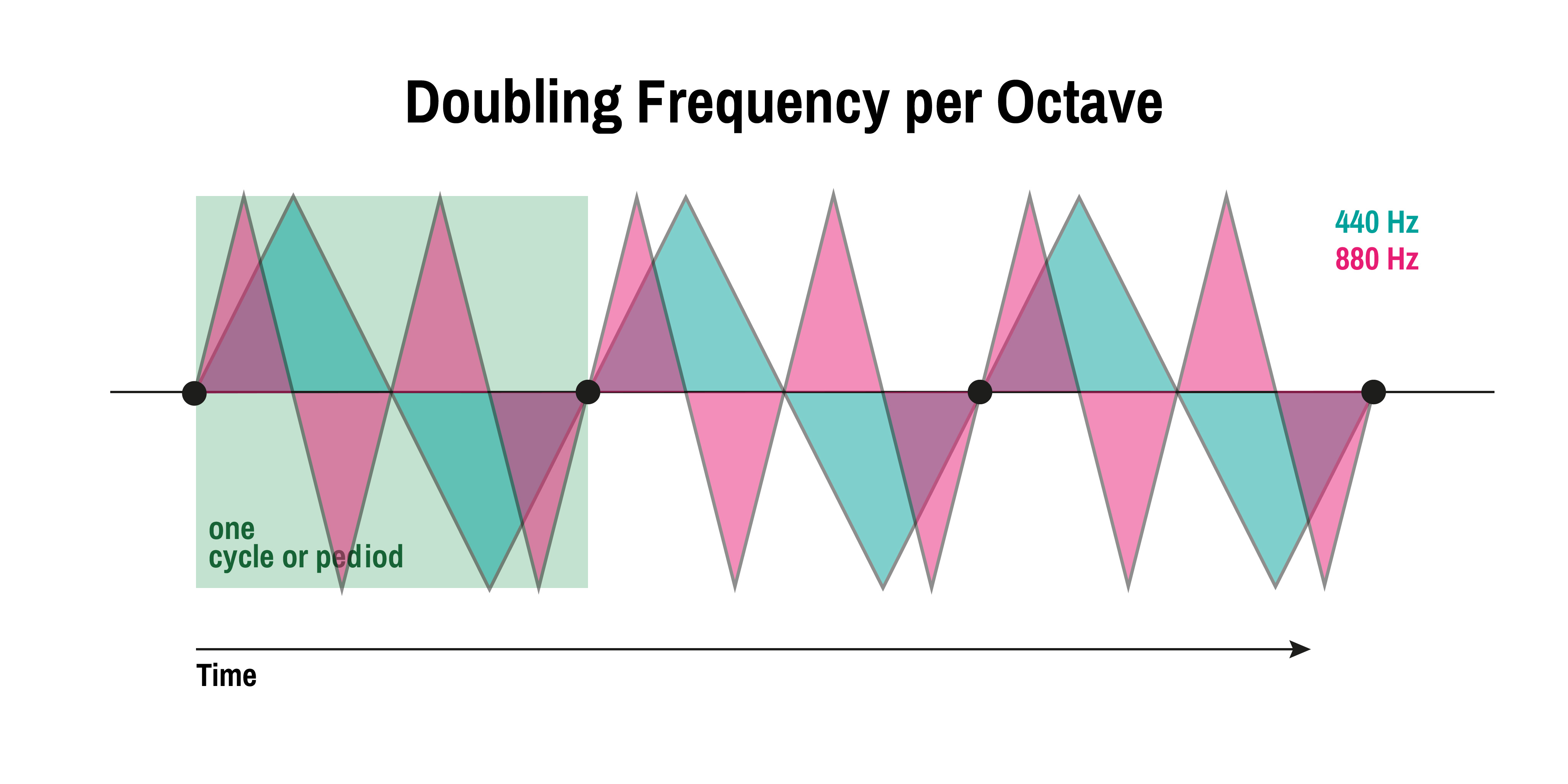
The illustration above shows a tone (blue) at 440 Hz and another tone one octave higher (pink) at 880 Hz. Because the frequency doubles, both waveforms share two intercept points where they cross zero line.
If you play the same note in different octaves, like an A3 and A4, the waveform stays regular and just changes its shape.
For this reason, the second note just changes the sound, but not the perceived pitch of the tone. Most sounds are in fact a waveform with a base frequency and many layers of waveforms in doubled frequency steps above. These doubled frequency layers on top of the base frequency are called overtones.
Playing a note on different octaves will change its pitch, but it is the same note. The note A1, A2, A3, A4, A5, A6 are still the note A - just at a different pitch.
Overtones
Overtones are frequencies which are part of a sound and define the character of it. They do not alter its perceived pitch.
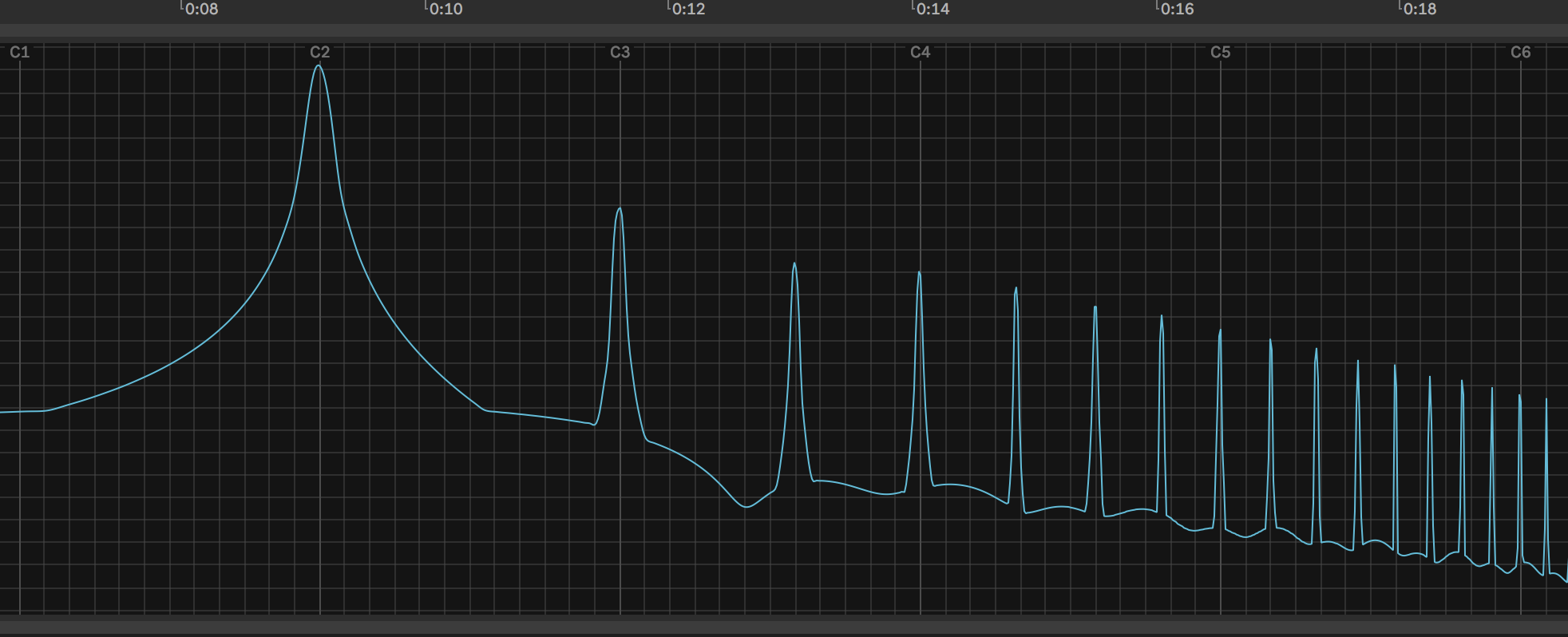
The image above shows a sound with many overtones. You see, the base frequency of the tone is C2, and there are strong overtones on C3, C4, C5 and C6.
Semitones
A semitone, also called step or halftone, is the smallest musical interval used in western music.

On the keyboard of a piano, a semitone is the smallest change in a melody you can play. If you go a semitone up from a C4, you land on the C#4. If you go a semitone down from a C4, you land on the B3.
In digital audio workstations, the term semitone is often also called “semi” or just “st”. Therefore, if you read “+5 st”, it means adding or transposing a note by five semitone upwards.
Cents
A cent is a smaller unit, which is mainly used in digital music production. A cent is 1/100 of a semitone. The unit is often displayed at places where you tune or detune an instrument. Often you read the shortcut “ct” in software synthesizers, where you can detune a sound.
Whole Tone
A whole tone is an interval of two semitones.
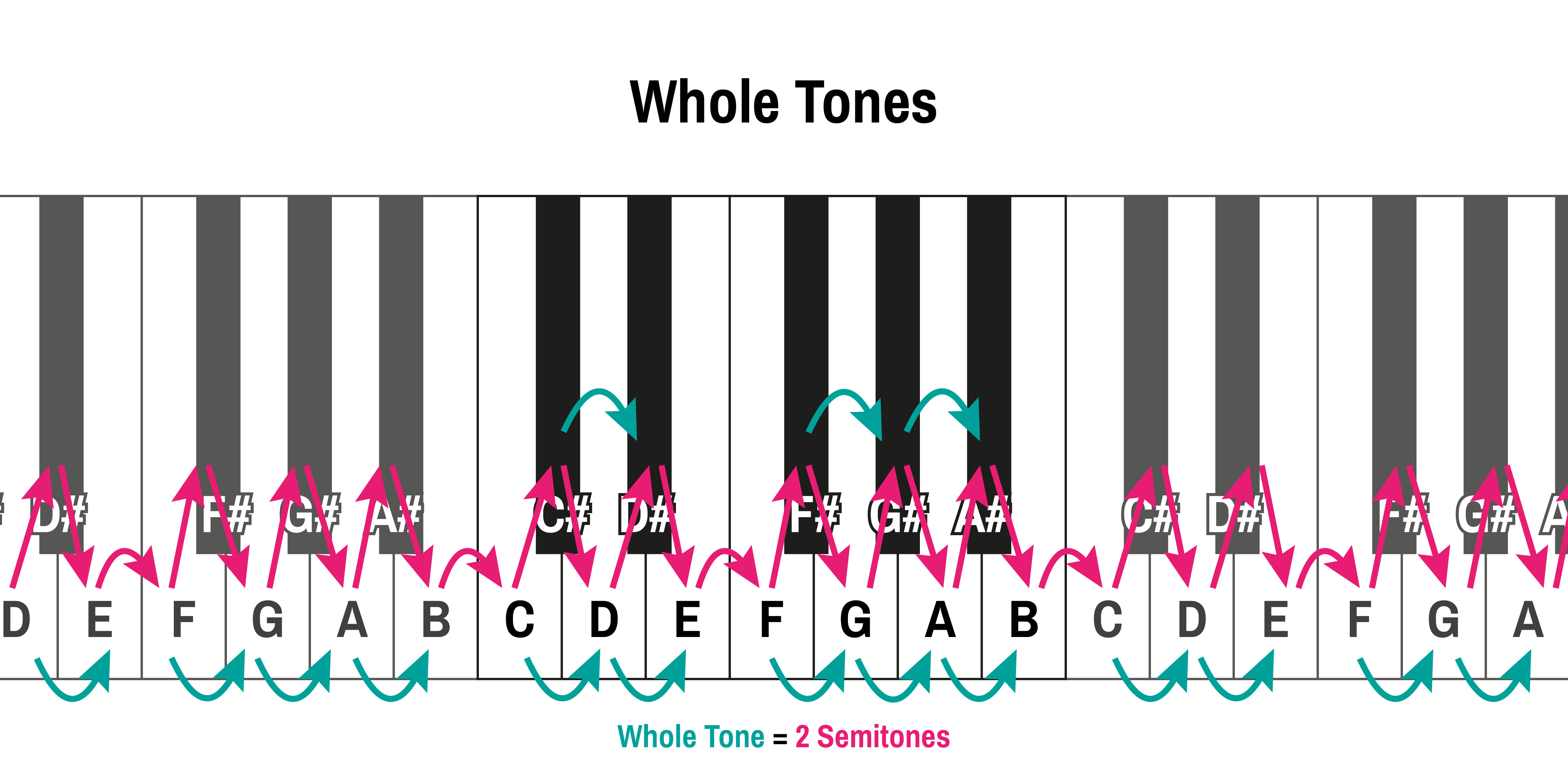
It can be confusing that a whole tone is two semitones, and therefore you move two steps in the 12 notes of the chromatic scale and not just a single one.
Be aware that not every distance between two white keys is a whole tone. The distance between E → F and B → C is only a semitone.
Usage in Modern Music
In digital music production, you will rarely use this term. Nevertheless, semitones and whole tones play an important role defining musical scales and chords. More about this later.
Musical Scale
In modern western music, a musical scale is a set of notes that form the fundamental basis of musical composition. The scale and key for a composition (or part of it) is the most important information you need to know, or to define.
In pop music, only two modes of scales are used:
- Major Scales
- Minor Scales
The Key
A scale is defined by its key and its mode. The key is the root note of the scale. Therefore, you call the key for a composition e.g. “C major”, “A# minor”.
The information of the scale and key is also called key signature. In sheet music, the key and mode is not expressed by text, but with sharp- and flat-signs on the staff. I do not cover this topic, there are good online references if you need to find the key from the signature on the staff.
Alternative Writings of the Scale and Key
The mode of a scale is not always spelled out, there are alternative ways to express it:
- A single uppercase note name, like A stands for a major scale.
- A minor scale is sometimes expressed by adding the lowercase letter m to the uppercase note name. The key Am means “A minor”.
- Sometimes, lowercase note names are used to express minor scales. If you find just “a” as key, it usually means “A minor”.
Major Scales
To play a scale, you start at the root note and follow the pattern of intervals for the chosen mode. The following illustration shows one of the simplest one, the C major scale:
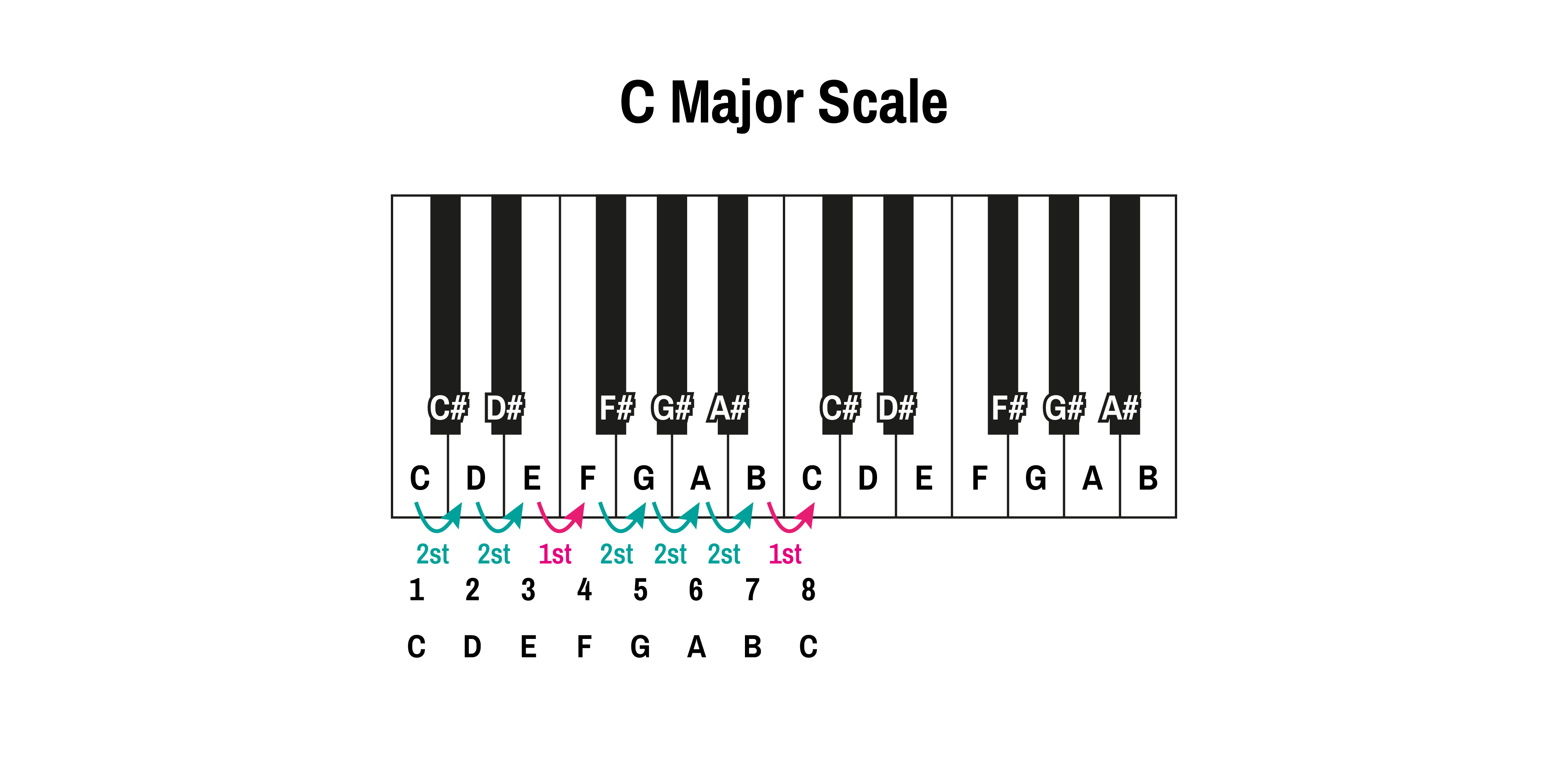
The C major scale is not only the simples one, it also visualizes the general pattern of all major scaled on the piano keyboard.
The Major Scale Pattern
The pattern of intervals for all major scales is:
You do not need anything fancy to remember this pattern. If you have a piano keyboard in front of you, just look at the intervals of the white keys, starting from C. This is the major pattern, that you can apply to any key.
All 12 Major Scales
Because there are 12 possible root notes, there are 12 major scales. Each scale starts at a different note, but uses the same pattern.
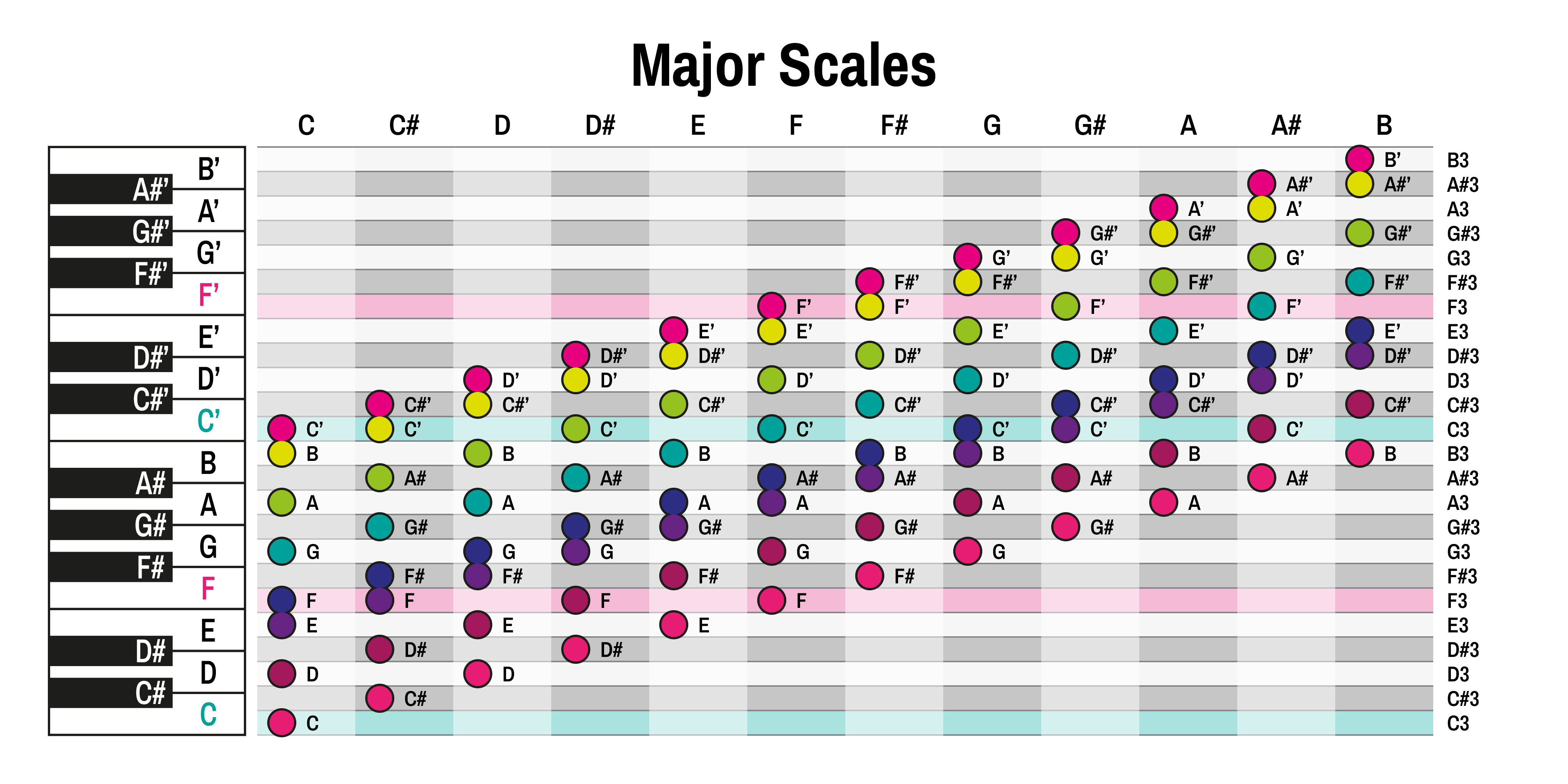
Each column in the illustration above describes one of the major scales. On top, you see the key and therefore the root note of the scale. Each dot on the column is one of the notes in this scale.
The notes in each scale are numbered from one to eight and have individual names. In the illustration, these notes have different colours.
- ● Tonic
- ● Supertonic
- ● Mediant
- ● Subdominant
- ● Dominant
- ● Submediant
- ● Leading tone (or leading note)
- ● Tonic (the same note, the same as 1)
I will use some of these names when we discuss chords, but you do not have to remember them. These numbers and names let you talk about notes in a scale without knowing the key in which they are played.
Minor Scales
The minor scales work similar like major scales, but the use a different pattern of intervals. The following illustration shows the simplest minor scale, the A minor scale:
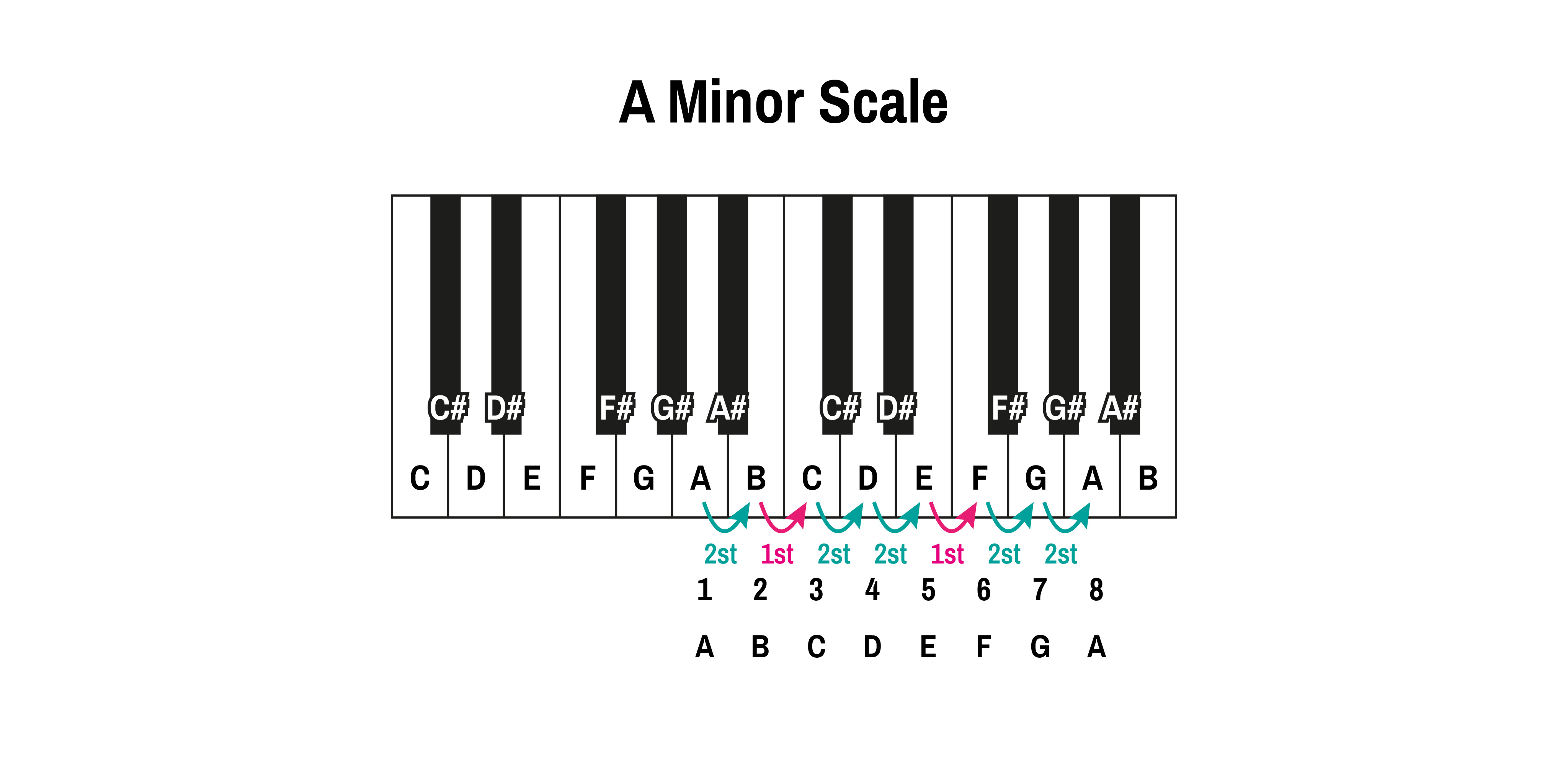
The A minor scale is not only the simples one, it also visualizes the general pattern of all minor scales on the piano keyboard.
The Major Scale Pattern
The pattern of intervals for all minor scales is:
As with the major scale, you do not need anything fancy to remember this pattern either. If you have a piano keyboard in front of you, just look at the intervals of the white keys, this time starting from A. This is the minor pattern, that you can apply to any key.
All 12 Minor Scales
And like with the major scale, there are 12 possible root notes for the minor scale as well. Each scale starts at a different note, but uses the same pattern.
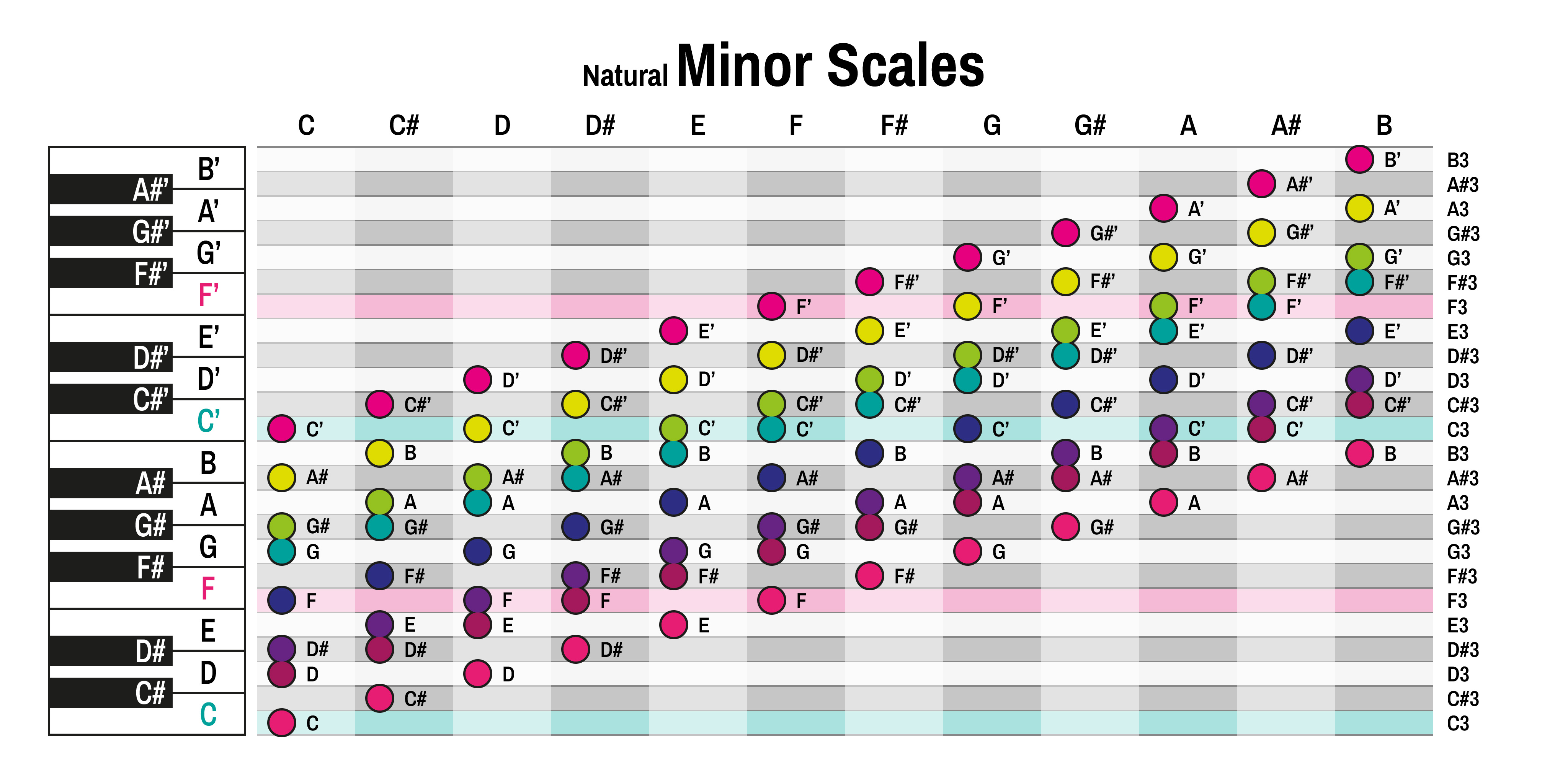
Each column in the illustration above describes one of the minor scales. On top, you see the key and therefore the root note of the scale. Each dot on the column is one of the notes in this scale.
The notes have almost the same name as the ones in the major scale. The only difference is the 7th note, which is called subtonic instead of leading tone.
- ● Tonic
- ● Supertonic
- ● Mediant
- ● Subdominant
- ● Dominant
- ● Submediant
- ● Subtonic (the only difference to the major scale)
- ● Tonic (the same note, the same as 1)
You don’t need to remember these names. An important fact is, that each of the shown major and minor scales are a set of seven different notes.
More About Scales
Scales and Octaves
For the two simple scales we use, the major and (natural) minor scale, it’s set of notes repeat in each octave. Therefore, if you know all seven notes of the scale you know all possible notes for your music composition on the whole piano keyboard.
E.g. the *E major scale consists of the notes E, F#, G#, A, B, C# and D#. These notes repeat over all octave, no matter where you start:
…, A1, B1, C#2, D#2, E2, F#2, G#2, A2, B2, C#3, D#3, E3, F#3, G#3, A3, B3, C#4, D#4, E4, F#4, G#4, A4, B4, …
Relative Minors
If you tried a few major and minor scales on your keyboard, you probably noticed that there is a minor scale for each major scale with exactly the same notes.
Look at the notes of the C major scale:
Now, look at the notes of the A minor scale:
Both scales have the exact same notes, they just start at a different root note.
| Major | C | G | D | A | E | B | F# | C# | G# | D# | A# | F |
|---|---|---|---|---|---|---|---|---|---|---|---|---|
| Minor | A | E | B | F# | C# | G# | D# | A# | F | C | G | D |
Scales in your Digital Audio Workstation (DAW)
All modern digital audio workstations should know everything about scales, as they are essential for composing music. These tools will support you by either highlighting the notes or even limit the piano roll editor to notes in the selected scale.
The following illustration shows the piano roll of Ableton Live in chromatic mode:
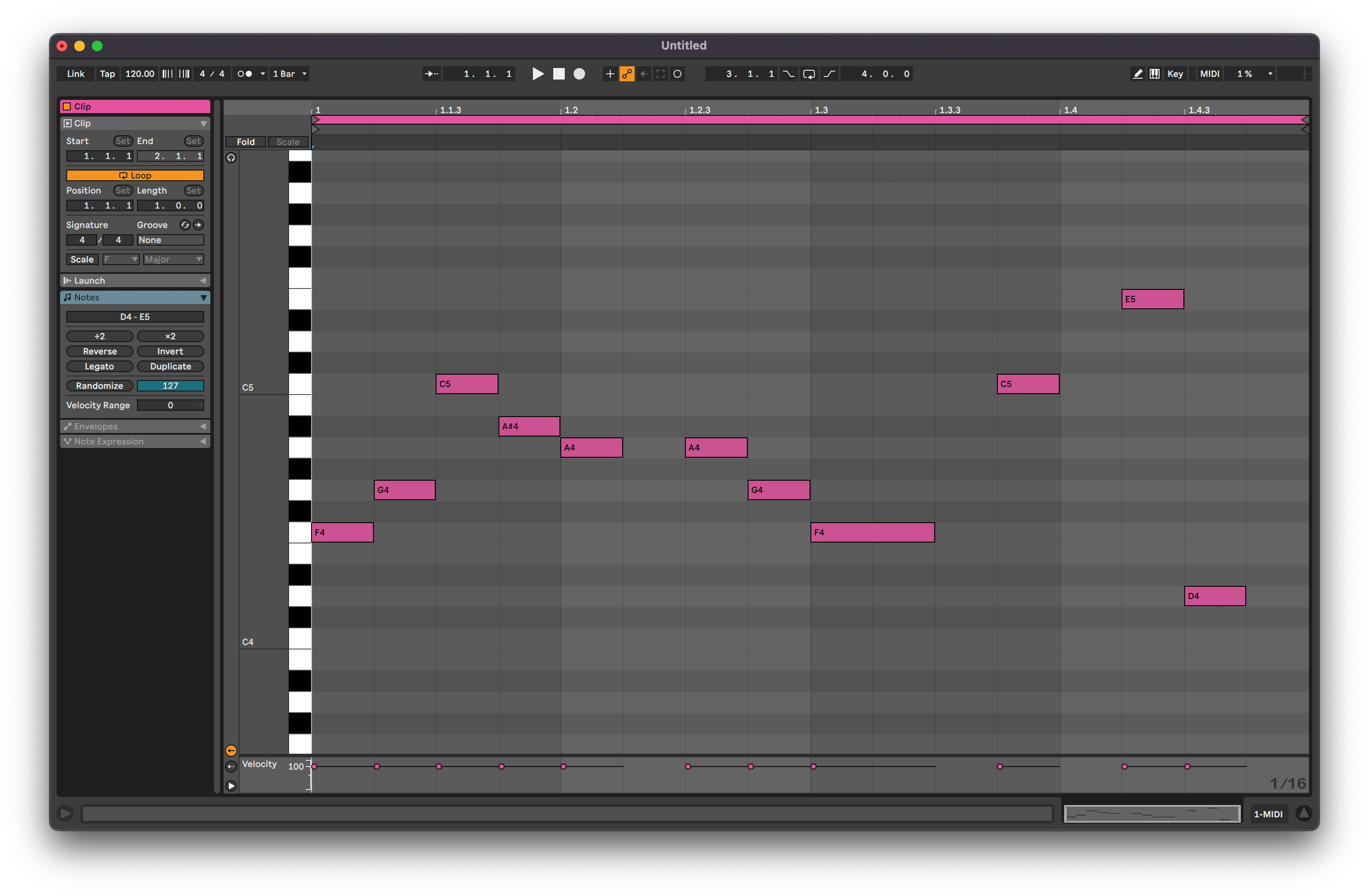
In the next screenshot, you see the piano roll in the selected scale:
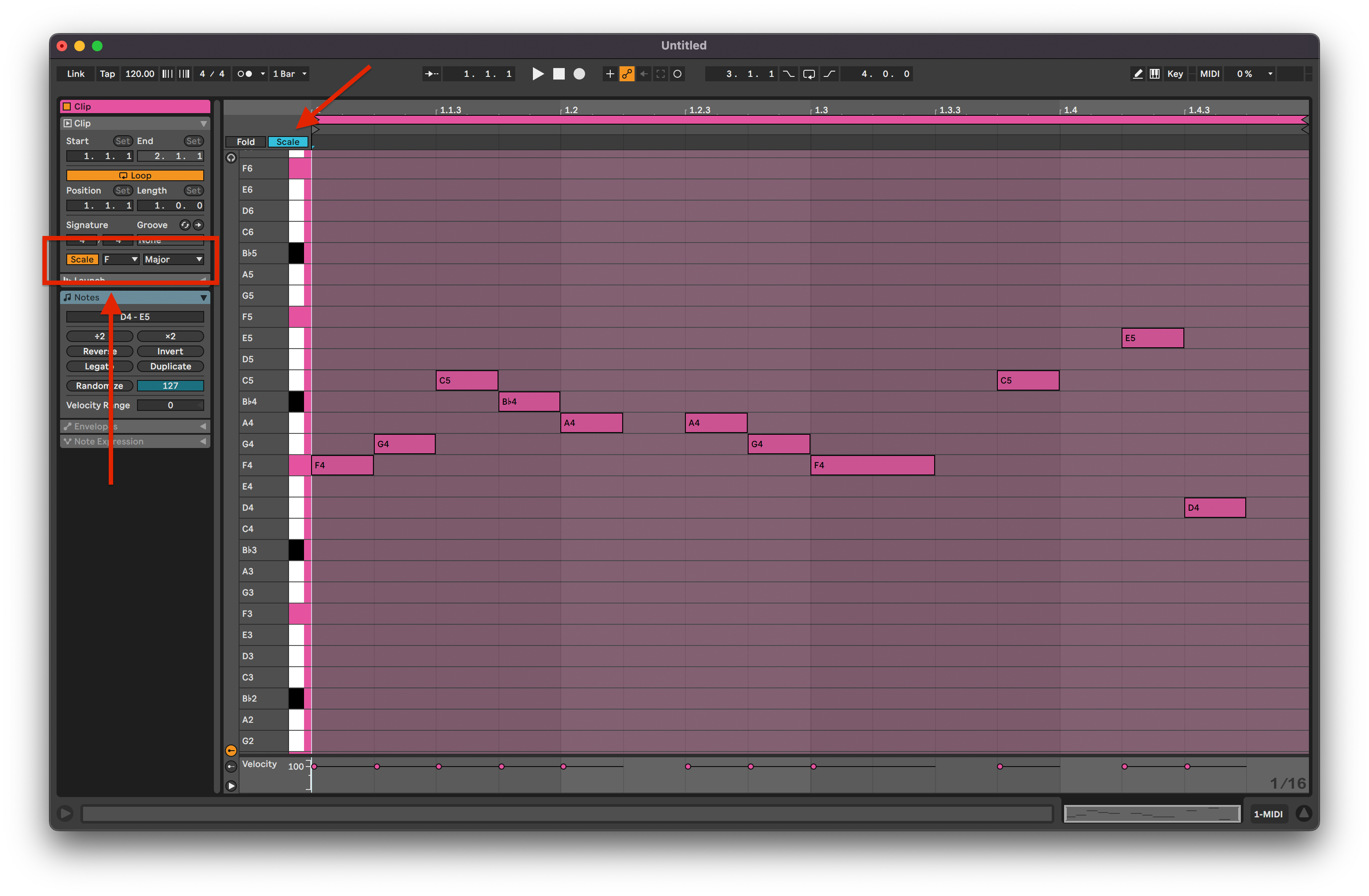
Time and the Beat
Tones and their pitch are important elements of music, but without time there is no rhythm and there are no melodies.
The Beat and the Measure (or Bar)
In music, a beat divides time into equal lengths. Like the dividers on a clock: For every minute, the clock has 60 seconds and each tick of the second hand is a beat.
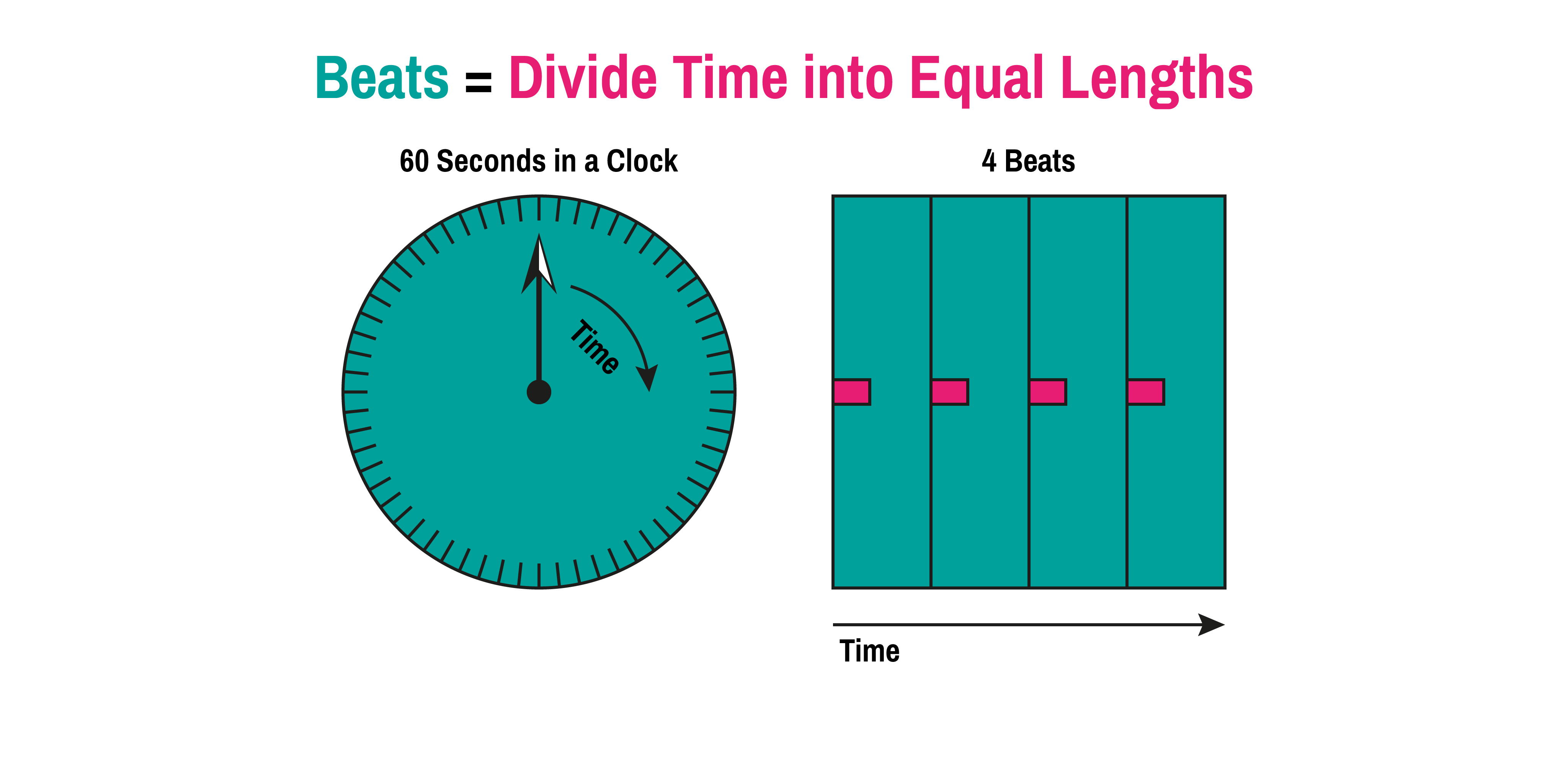
Another term is measure or bar. A measure defines one logical unit of a composition. Similar as one minute has 60 seconds, a measure has a given number of beats.
In music, each piece (or section of a piece) has a defined time signature. This time signature defines how many beats one measure has and also how the time in each measure is divided.
Time Signature
The time signature is written in form of a fraction:
While in there are many time signatures, like 2/2, 3/4, 7/8 or even 9/8, in modern pop music 4/4 is used most of the time.
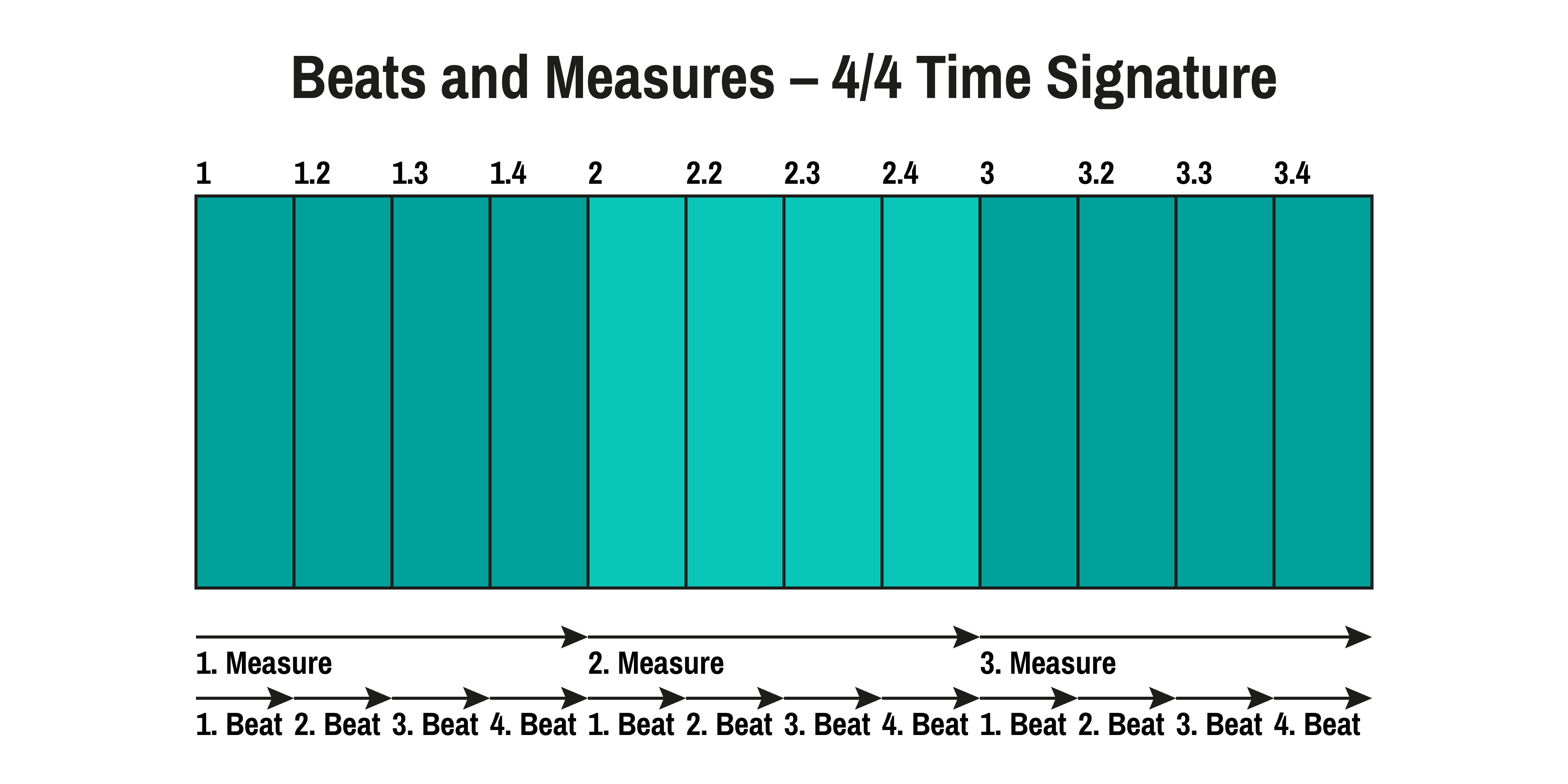
The time signature 4/4 means, there are four beats per measure and the note value for one beat is 1/4 of a whole note.
The next table contains a number of common time signatures and their meaning.
| Time Signature: | 4/4 | 2/4 | 3/4 | 2/2 | 6/8 | 9/8 | 12/8 |
|---|---|---|---|---|---|---|---|
| Beats per Measure: | 4 | 2 | 3 | 2 | 6 | 9 | 12 |
| Note Value per Beat: | 1/4 | 1/4 | 1/4 | 1/2 | 1/8 | 1/8 | 1/8 |
Tempo / Speed
The tempo or speed of music is measured in beats per minute, or short BPM. If you read “120 BPM”, it means that there are 120 beats per minute, and therefore two beats per second.
Note Values
The value of a note expresses how long it is played. This duration is expressed as a fraction of a whole note. This is all based on the original notation of notes, yet these terms are still used in your DAW, e.g. when you quantize notes or select a grid for your editor.
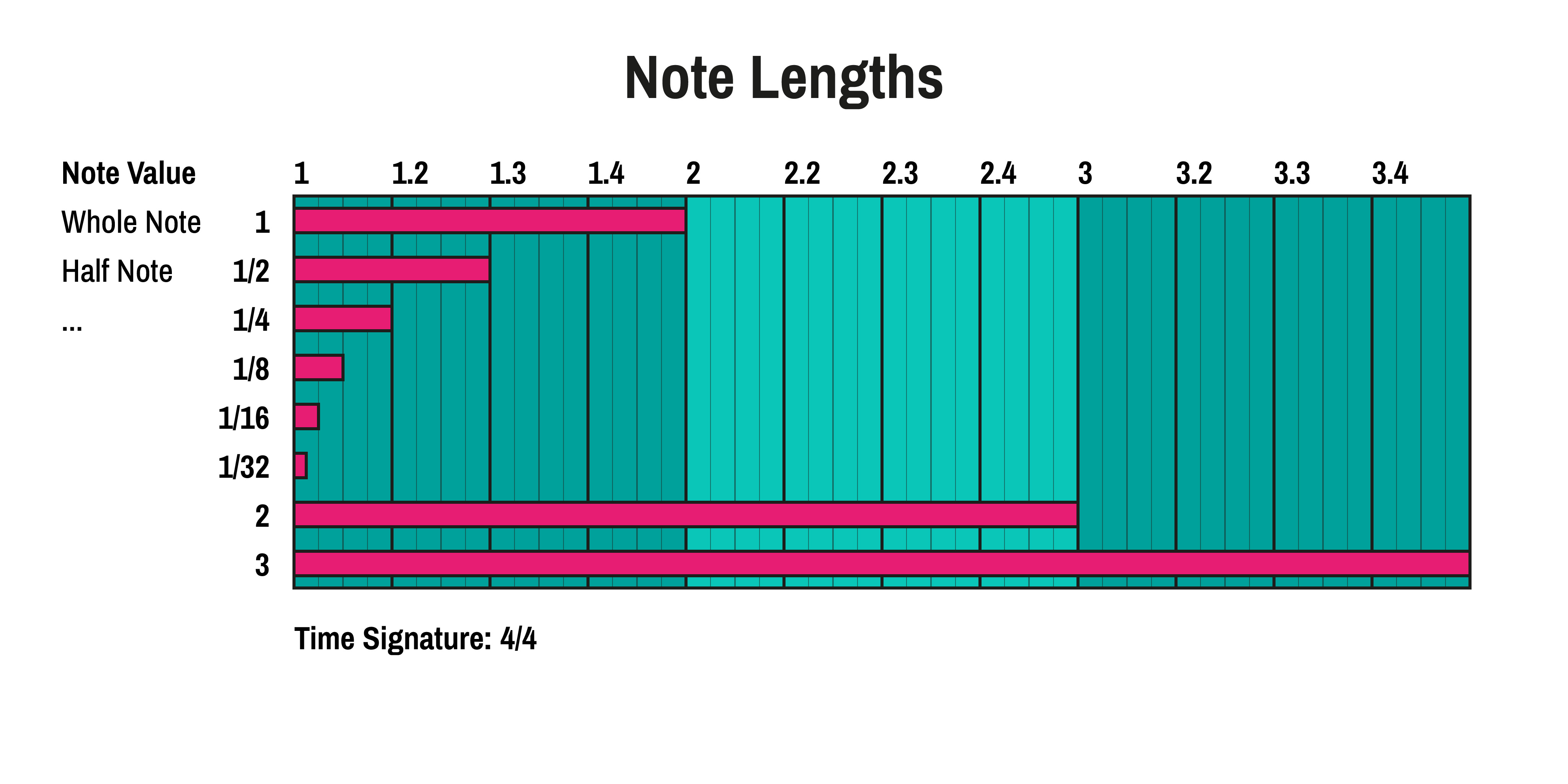
The shortest note value is usually a 1/32 note, and 1/16 notes are the fastest notes in a melody. In case you have a many 1/32 notes in your music, it is an indicator that the speed of your music is too slow. By doubling the speed of your music, you can make the note values higher with no actual change of the length.
E.g. your melody is played at 60 BPM and has many 1/32 notes, it is probably better to double the speed to 120 BPM and use 1/16 notes.
Note Values in Digital Audio Workstations
As we do not work with music notation, but in a piano roll editor, note values and therefore their lengths are expressed by the actual length of the bar that represents the note.
Will be Continued...
This documentation will be continued…
GNU Free Documentation License
Version 1.3, 3 November 2008
Copyright (C) 2000, 2001, 2002, 2007, 2008 Free Software Foundation, Inc. https://fsf.org/
Everyone is permitted to copy and distribute verbatim copies of this license document, but changing it is not allowed.
0. PREAMBLE
The purpose of this License is to make a manual, textbook, or other functional and useful document “free” in the sense of freedom: to assure everyone the effective freedom to copy and redistribute it, with or without modifying it, either commercially or noncommercially. Secondarily, this License preserves for the author and publisher a way to get credit for their work, while not being considered responsible for modifications made by others.
This License is a kind of “copyleft”, which means that derivative works of the document must themselves be free in the same sense. It complements the GNU General Public License, which is a copyleft license designed for free software.
We have designed this License in order to use it for manuals for free software, because free software needs free documentation: a free program should come with manuals providing the same freedoms that the software does. But this License is not limited to software manuals; it can be used for any textual work, regardless of subject matter or whether it is published as a printed book. We recommend this License principally for works whose purpose is instruction or reference.
1. APPLICABILITY AND DEFINITIONS
This License applies to any manual or other work, in any medium, that contains a notice placed by the copyright holder saying it can be distributed under the terms of this License. Such a notice grants a world-wide, royalty-free license, unlimited in duration, to use that work under the conditions stated herein. The “Document”, below, refers to any such manual or work. Any member of the public is a licensee, and is addressed as “you”. You accept the license if you copy, modify or distribute the work in a way requiring permission under copyright law.
A “Modified Version” of the Document means any work containing the Document or a portion of it, either copied verbatim, or with modifications and/or translated into another language.
A “Secondary Section” is a named appendix or a front-matter section of the Document that deals exclusively with the relationship of the publishers or authors of the Document to the Document’s overall subject (or to related matters) and contains nothing that could fall directly within that overall subject. (Thus, if the Document is in part a textbook of mathematics, a Secondary Section may not explain any mathematics.) The relationship could be a matter of historical connection with the subject or with related matters, or of legal, commercial, philosophical, ethical or political position regarding them.
The “Invariant Sections” are certain Secondary Sections whose titles are designated, as being those of Invariant Sections, in the notice that says that the Document is released under this License. If a section does not fit the above definition of Secondary then it is not allowed to be designated as Invariant. The Document may contain zero Invariant Sections. If the Document does not identify any Invariant Sections then there are none.
The “Cover Texts” are certain short passages of text that are listed, as Front-Cover Texts or Back-Cover Texts, in the notice that says that the Document is released under this License. A Front-Cover Text may be at most 5 words, and a Back-Cover Text may be at most 25 words.
A “Transparent” copy of the Document means a machine-readable copy, represented in a format whose specification is available to the general public, that is suitable for revising the document straightforwardly with generic text editors or (for images composed of pixels) generic paint programs or (for drawings) some widely available drawing editor, and that is suitable for input to text formatters or for automatic translation to a variety of formats suitable for input to text formatters. A copy made in an otherwise Transparent file format whose markup, or absence of markup, has been arranged to thwart or discourage subsequent modification by readers is not Transparent. An image format is not Transparent if used for any substantial amount of text. A copy that is not “Transparent” is called “Opaque”.
Examples of suitable formats for Transparent copies include plain ASCII without markup, Texinfo input format, LaTeX input format, SGML or XML using a publicly available DTD, and standard-conforming simple HTML, PostScript or PDF designed for human modification. Examples of transparent image formats include PNG, XCF and JPG. Opaque formats include proprietary formats that can be read and edited only by proprietary word processors, SGML or XML for which the DTD and/or processing tools are not generally available, and the machine-generated HTML, PostScript or PDF produced by some word processors for output purposes only.
The “Title Page” means, for a printed book, the title page itself, plus such following pages as are needed to hold, legibly, the material this License requires to appear in the title page. For works in formats which do not have any title page as such, “Title Page” means the text near the most prominent appearance of the work’s title, preceding the beginning of the body of the text.
The “publisher” means any person or entity that distributes copies of the Document to the public.
A section “Entitled XYZ” means a named subunit of the Document whose title either is precisely XYZ or contains XYZ in parentheses following text that translates XYZ in another language. (Here XYZ stands for a specific section name mentioned below, such as “Acknowledgements”, “Dedications”, “Endorsements”, or “History”.) To “Preserve the Title” of such a section when you modify the Document means that it remains a section “Entitled XYZ” according to this definition.
The Document may include Warranty Disclaimers next to the notice which states that this License applies to the Document. These Warranty Disclaimers are considered to be included by reference in this License, but only as regards disclaiming warranties: any other implication that these Warranty Disclaimers may have is void and has no effect on the meaning of this License.
2. VERBATIM COPYING
You may copy and distribute the Document in any medium, either commercially or noncommercially, provided that this License, the copyright notices, and the license notice saying this License applies to the Document are reproduced in all copies, and that you add no other conditions whatsoever to those of this License. You may not use technical measures to obstruct or control the reading or further copying of the copies you make or distribute. However, you may accept compensation in exchange for copies. If you distribute a large enough number of copies you must also follow the conditions in section 3.
You may also lend copies, under the same conditions stated above, and you may publicly display copies.
3. COPYING IN QUANTITY
If you publish printed copies (or copies in media that commonly have printed covers) of the Document, numbering more than 100, and the Document’s license notice requires Cover Texts, you must enclose the copies in covers that carry, clearly and legibly, all these Cover Texts: Front-Cover Texts on the front cover, and Back-Cover Texts on the back cover. Both covers must also clearly and legibly identify you as the publisher of these copies. The front cover must present the full title with all words of the title equally prominent and visible. You may add other material on the covers in addition. Copying with changes limited to the covers, as long as they preserve the title of the Document and satisfy these conditions, can be treated as verbatim copying in other respects.
If the required texts for either cover are too voluminous to fit legibly, you should put the first ones listed (as many as fit reasonably) on the actual cover, and continue the rest onto adjacent pages.
If you publish or distribute Opaque copies of the Document numbering more than 100, you must either include a machine-readable Transparent copy along with each Opaque copy, or state in or with each Opaque copy a computer-network location from which the general network-using public has access to download using public-standard network protocols a complete Transparent copy of the Document, free of added material. If you use the latter option, you must take reasonably prudent steps, when you begin distribution of Opaque copies in quantity, to ensure that this Transparent copy will remain thus accessible at the stated location until at least one year after the last time you distribute an Opaque copy (directly or through your agents or retailers) of that edition to the public.
It is requested, but not required, that you contact the authors of the Document well before redistributing any large number of copies, to give them a chance to provide you with an updated version of the Document.
4. MODIFICATIONS
You may copy and distribute a Modified Version of the Document under the conditions of sections 2 and 3 above, provided that you release the Modified Version under precisely this License, with the Modified Version filling the role of the Document, thus licensing distribution and modification of the Modified Version to whoever possesses a copy of it. In addition, you must do these things in the Modified Version:
- A. Use in the Title Page (and on the covers, if any) a title distinct from that of the Document, and from those of previous versions (which should, if there were any, be listed in the History section of the Document). You may use the same title as a previous version if the original publisher of that version gives permission.
- B. List on the Title Page, as authors, one or more persons or entities responsible for authorship of the modifications in the Modified Version, together with at least five of the principal authors of the Document (all of its principal authors, if it has fewer than five), unless they release you from this requirement.
- C. State on the Title page the name of the publisher of the Modified Version, as the publisher.
- D. Preserve all the copyright notices of the Document.
- E. Add an appropriate copyright notice for your modifications adjacent to the other copyright notices.
- F. Include, immediately after the copyright notices, a license notice giving the public permission to use the Modified Version under the terms of this License, in the form shown in the Addendum below.
- G. Preserve in that license notice the full lists of Invariant Sections and required Cover Texts given in the Document’s license notice.
- H. Include an unaltered copy of this License.
- I. Preserve the section Entitled “History”, Preserve its Title, and add to it an item stating at least the title, year, new authors, and publisher of the Modified Version as given on the Title Page. If there is no section Entitled “History” in the Document, create one stating the title, year, authors, and publisher of the Document as given on its Title Page, then add an item describing the Modified Version as stated in the previous sentence.
- J. Preserve the network location, if any, given in the Document for public access to a Transparent copy of the Document, and likewise the network locations given in the Document for previous versions it was based on. These may be placed in the “History” section. You may omit a network location for a work that was published at least four years before the Document itself, or if the original publisher of the version it refers to gives permission.
- K. For any section Entitled “Acknowledgements” or “Dedications”, Preserve the Title of the section, and preserve in the section all the substance and tone of each of the contributor acknowledgements and/or dedications given therein.
- L. Preserve all the Invariant Sections of the Document, unaltered in their text and in their titles. Section numbers or the equivalent are not considered part of the section titles.
- M. Delete any section Entitled “Endorsements”. Such a section may not be included in the Modified Version.
- N. Do not retitle any existing section to be Entitled “Endorsements” or to conflict in title with any Invariant Section.
- O. Preserve any Warranty Disclaimers.
If the Modified Version includes new front-matter sections or appendices that qualify as Secondary Sections and contain no material copied from the Document, you may at your option designate some or all of these sections as invariant. To do this, add their titles to the list of Invariant Sections in the Modified Version’s license notice. These titles must be distinct from any other section titles.
You may add a section Entitled “Endorsements”, provided it contains nothing but endorsements of your Modified Version by various parties—for example, statements of peer review or that the text has been approved by an organization as the authoritative definition of a standard.
You may add a passage of up to five words as a Front-Cover Text, and a passage of up to 25 words as a Back-Cover Text, to the end of the list of Cover Texts in the Modified Version. Only one passage of Front-Cover Text and one of Back-Cover Text may be added by (or through arrangements made by) any one entity. If the Document already includes a cover text for the same cover, previously added by you or by arrangement made by the same entity you are acting on behalf of, you may not add another; but you may replace the old one, on explicit permission from the previous publisher that added the old one.
The author(s) and publisher(s) of the Document do not by this License give permission to use their names for publicity for or to assert or imply endorsement of any Modified Version.
5. COMBINING DOCUMENTS
You may combine the Document with other documents released under this License, under the terms defined in section 4 above for modified versions, provided that you include in the combination all of the Invariant Sections of all of the original documents, unmodified, and list them all as Invariant Sections of your combined work in its license notice, and that you preserve all their Warranty Disclaimers.
The combined work need only contain one copy of this License, and multiple identical Invariant Sections may be replaced with a single copy. If there are multiple Invariant Sections with the same name but different contents, make the title of each such section unique by adding at the end of it, in parentheses, the name of the original author or publisher of that section if known, or else a unique number. Make the same adjustment to the section titles in the list of Invariant Sections in the license notice of the combined work.
In the combination, you must combine any sections Entitled “History” in the various original documents, forming one section Entitled “History”; likewise combine any sections Entitled “Acknowledgements”, and any sections Entitled “Dedications”. You must delete all sections Entitled “Endorsements”.
6. COLLECTIONS OF DOCUMENTS
You may make a collection consisting of the Document and other documents released under this License, and replace the individual copies of this License in the various documents with a single copy that is included in the collection, provided that you follow the rules of this License for verbatim copying of each of the documents in all other respects.
You may extract a single document from such a collection, and distribute it individually under this License, provided you insert a copy of this License into the extracted document, and follow this License in all other respects regarding verbatim copying of that document.
7. AGGREGATION WITH INDEPENDENT WORKS
A compilation of the Document or its derivatives with other separate and independent documents or works, in or on a volume of a storage or distribution medium, is called an “aggregate” if the copyright resulting from the compilation is not used to limit the legal rights of the compilation’s users beyond what the individual works permit. When the Document is included in an aggregate, this License does not apply to the other works in the aggregate which are not themselves derivative works of the Document.
If the Cover Text requirement of section 3 is applicable to these copies of the Document, then if the Document is less than one half of the entire aggregate, the Document’s Cover Texts may be placed on covers that bracket the Document within the aggregate, or the electronic equivalent of covers if the Document is in electronic form. Otherwise they must appear on printed covers that bracket the whole aggregate.
8. TRANSLATION
Translation is considered a kind of modification, so you may distribute translations of the Document under the terms of section 4. Replacing Invariant Sections with translations requires special permission from their copyright holders, but you may include translations of some or all Invariant Sections in addition to the original versions of these Invariant Sections. You may include a translation of this License, and all the license notices in the Document, and any Warranty Disclaimers, provided that you also include the original English version of this License and the original versions of those notices and disclaimers. In case of a disagreement between the translation and the original version of this License or a notice or disclaimer, the original version will prevail.
If a section in the Document is Entitled “Acknowledgements”, “Dedications”, or “History”, the requirement (section 4) to Preserve its Title (section 1) will typically require changing the actual title.
9. TERMINATION
You may not copy, modify, sublicense, or distribute the Document except as expressly provided under this License. Any attempt otherwise to copy, modify, sublicense, or distribute it is void, and will automatically terminate your rights under this License.
However, if you cease all violation of this License, then your license from a particular copyright holder is reinstated (a) provisionally, unless and until the copyright holder explicitly and finally terminates your license, and (b) permanently, if the copyright holder fails to notify you of the violation by some reasonable means prior to 60 days after the cessation.
Moreover, your license from a particular copyright holder is reinstated permanently if the copyright holder notifies you of the violation by some reasonable means, this is the first time you have received notice of violation of this License (for any work) from that copyright holder, and you cure the violation prior to 30 days after your receipt of the notice.
Termination of your rights under this section does not terminate the licenses of parties who have received copies or rights from you under this License. If your rights have been terminated and not permanently reinstated, receipt of a copy of some or all of the same material does not give you any rights to use it.
10. FUTURE REVISIONS OF THIS LICENSE
The Free Software Foundation may publish new, revised versions of the GNU Free Documentation License from time to time. Such new versions will be similar in spirit to the present version, but may differ in detail to address new problems or concerns. See https://www.gnu.org/licenses/.
Each version of the License is given a distinguishing version number. If the Document specifies that a particular numbered version of this License “or any later version” applies to it, you have the option of following the terms and conditions either of that specified version or of any later version that has been published (not as a draft) by the Free Software Foundation. If the Document does not specify a version number of this License, you may choose any version ever published (not as a draft) by the Free Software Foundation. If the Document specifies that a proxy can decide which future versions of this License can be used, that proxy’s public statement of acceptance of a version permanently authorizes you to choose that version for the Document.
11. RELICENSING
“Massive Multiauthor Collaboration Site” (or “MMC Site”) means any World Wide Web server that publishes copyrightable works and also provides prominent facilities for anybody to edit those works. A public wiki that anybody can edit is an example of such a server. A “Massive Multiauthor Collaboration” (or “MMC”) contained in the site means any set of copyrightable works thus published on the MMC site.
“CC-BY-SA” means the Creative Commons Attribution-Share Alike 3.0 license published by Creative Commons Corporation, a not-for-profit corporation with a principal place of business in San Francisco, California, as well as future copyleft versions of that license published by that same organization.
“Incorporate” means to publish or republish a Document, in whole or in part, as part of another Document.
An MMC is “eligible for relicensing” if it is licensed under this License, and if all works that were first published under this License somewhere other than this MMC, and subsequently incorporated in whole or in part into the MMC, (1) had no cover texts or invariant sections, and (2) were thus incorporated prior to November 1, 2008.
The operator of an MMC Site may republish an MMC contained in the site under CC-BY-SA on the same site at any time before August 1, 2009, provided the MMC is eligible for relicensing.
ADDENDUM: How to use this License for your documents
To use this License in a document you have written, include a copy of the License in the document and put the following copyright and license notices just after the title page:
Copyright (C) YEAR YOUR NAME.
Permission is granted to copy, distribute and/or modify this document
under the terms of the GNU Free Documentation License, Version 1.3
or any later version published by the Free Software Foundation;
with no Invariant Sections, no Front-Cover Texts, and no Back-Cover Texts.
A copy of the license is included in the section entitled "GNU
Free Documentation License".
If you have Invariant Sections, Front-Cover Texts and Back-Cover Texts, replace the “with … Texts.” line with this:
with the Invariant Sections being LIST THEIR TITLES, with the
Front-Cover Texts being LIST, and with the Back-Cover Texts being LIST.
If you have Invariant Sections without Cover Texts, or some other combination of the three, merge those two alternatives to suit the situation.
If your document contains nontrivial examples of program code, we recommend releasing these examples in parallel under your choice of free software license, such as the GNU General Public License, to permit their use in free software.